Hybrid Device Fabrication Using Roll-to-Roll Printing for Personal Environmental Monitoring
Abstract
:1. Introduction
2. Personal Environmental Monitoring System
3. Fabrication of Hybrid R2R Printed Device
3.1. PCB Layer Design
3.2. Conversion to Printable Patterns and Passive Compensation
3.3. Printing of Multilayer Circuit, Active Compensation, and Component Assembling
4. Results and Discussion
4.1. Device Fabrication Results
4.2. Implementation of Personal Environment Monitoring System with Fabricated Device
5. Conclusions
Author Contributions
Funding
Institutional Review Board Statement
Informed Consent Statement
Data Availability Statement
Acknowledgments
Conflicts of Interest
References
- Kampa, M.; Castanas, E. Human health effects of air pollution. Environ. Pollut. 2008, 151, 362–367. [Google Scholar] [CrossRef]
- Chen, W.Y.; Yen, C.-C.; Xue, S.; Wang, H.; Stanciu, L.A. Surface Functionalization of Layered Molybdenum Disulfide for the Selective Detection of Volatile Organic Compounds at Room Temperature. ACS Appl. Mater. Interfaces 2019, 11, 34135–34143. [Google Scholar] [CrossRef]
- Lv, Z.; Hu, B.; Lv, H. Infrastructure Monitoring and Operation for Smart Cities Based on IoT System. IEEE Trans. Ind. Inform. 2019, 16, 1957–1962. [Google Scholar] [CrossRef]
- Malche, T.; Maheshwary, P.; Kumar, R. Environmental Monitoring System for Smart City Based on Secure Internet of Things (IoT) Architecture. Wirel. Pers. Commun. 2019, 107, 2143–2172. [Google Scholar] [CrossRef]
- Ullo, S.L.; Sinha, G.R. Advances in Smart Environment Monitoring Systems Using IoT and Sensors. Sensors 2020, 20, 3113. [Google Scholar] [CrossRef]
- Hajjaji, Y.; Boulila, W.; Farah, I.R.; Romdhani, I.; Hussain, A. Big data and IoT-based applications in smart environments: A systematic review. Comput. Sci. Rev. 2020, 39, 100318. [Google Scholar] [CrossRef]
- Castrejon-Pita, J.R.; Baxter, W.R.S.; Morgan, J.; Temple, S.; Martin, G.D.; Hutchings, I.M. Future, opportunities and challenges of inkjet technologies. At. Sprays 2013, 23, 541–565. [Google Scholar] [CrossRef] [Green Version]
- Bonnassieux, Y.; Brabec, C.J.; Cao, Y.; Carmichael, T.B.; Chabinyc, M.L.; Cheng, K.-T.; Cho, G.; Chung, A.; Cobb, C.L.; Distler, A.; et al. The 2021 flexible and printed electronics roadmap. Flex. Print. Electron. 2021, 6, 023001. [Google Scholar] [CrossRef]
- Shih, B.; Christianson, C.; Gillespie, K.; Lee, S.; Mayeda, J.; Huo, Z.; Tolley, M.T. Design Considerations for 3D Printed, Soft, Multimaterial Resistive Sensors for Soft Robotics. Front. Robot. AI 2019, 6, 30. [Google Scholar] [CrossRef] [Green Version]
- Chang, T.; Wojcik, C.; Su, Y.; Rogers, J.A.; Lee, T.H.; Fan, J.A. Characterization of stretchable serpentine microwave devices for wearable electronics. In 2017 IEEE MTT-S International Microwave Symposium (IMS); IEEE: New York, NY, USA, 2017; pp. 211–214. [Google Scholar] [CrossRef]
- Xie, Z.; Ji, B.; Huo, Q. Mechanics Design of Stretchable Near Field Communication Antenna With Serpentine Wires. J. Appl. Mech. 2018, 85, 045001. [Google Scholar] [CrossRef]
- Liu, G.; Tan, Q.; Kou, H.; Zhang, L.; Wang, J.; Lv, W.; Dong, H.; Xiong, J. A Flexible Temperature Sensor Based on Reduced Graphene Oxide for Robot Skin Used in Internet of Things. Sensors 2018, 18, 1400. [Google Scholar] [CrossRef] [Green Version]
- Gao, M.; Li, L.; Song, Y. Inkjet printing wearable electronic devices. J. Mater. Chem. C 2017, 5, 2971–2993. [Google Scholar] [CrossRef]
- Zavanelli, N.; Yeo, W.-H. Advances in Screen Printing of Conductive Nanomaterials for Stretchable Electronics. ACS Omega 2021, 6, 9344–9351. [Google Scholar] [CrossRef]
- Liu, C.; Huang, N.; Xu, F.; Tong, J.; Chen, Z.; Gui, X.; Fu, Y.; Lao, C. 3D Printing Technologies for Flexible Tactile Sensors toward Wearable Electronics and Electronic Skin. Polymers 2018, 10, 629. [Google Scholar] [CrossRef] [Green Version]
- Fernandes, D.F.; Majidi, C.; Tavakoli, M. Digitally printed stretchable electronics: A review. J. Mater. Chem. C 2019, 7, 14035–14068. [Google Scholar] [CrossRef]
- Nagamine, K.; Nomura, A.; Ichimura, Y.; Izawa, R.; Sasaki, S.; Furusawa, H.; Matsui, H.; Tokito, S. Printed Organic Transistor-based Biosensors for Non-invasive Sweat Analysis. Anal. Sci. 2020, 36, 291–302. [Google Scholar] [CrossRef] [PubMed] [Green Version]
- Iqbal, S.M.A.; Mahgoub, I.; Du, E.; Leavitt, M.A.; Asghar, W. Advances in healthcare wearable devices. NPJ Flex. Electron. 2021, 5, 1–14. [Google Scholar] [CrossRef]
- Liao, Y.; Zhang, R.; Qian, J. Printed electronics based on inorganic conductive nanomaterials and their applications in intelligent food packaging. RSC Adv. 2019, 9, 29154–29172. [Google Scholar] [CrossRef] [Green Version]
- Wang, Y.-F.; Sekine, T.; Takeda, Y.; Yokosawa, K.; Matsui, H.; Kumaki, D.; Shiba, T.; Nishikawa, T.; Tokito, S. Fully Printed PEDOT:PSS-based Temperature Sensor with High Humidity Stability for Wireless Healthcare Monitoring. Sci. Rep. 2020, 10, 1–8. [Google Scholar] [CrossRef] [Green Version]
- Dong, Y.; Bao, C.; Kim, W.S. Sustainable Additive Manufacturing of Printed Circuit Boards. Joule 2018, 2, 579–582. [Google Scholar] [CrossRef] [Green Version]
- Hakola, L.; Jansson, E.; Futsch, R.; Happonen, T.; Thenot, V.; Depres, G.; Rougier, A.; Smolander, M. Sustainable roll-to-roll manufactured multi-layer smart label. Int. J. Adv. Manuf. Technol. 2021, 117, 2921–2934. [Google Scholar] [CrossRef]
- Jo, M.; Kim, S.; Cho, G.; Lee, T.-M.; Lee, J.; Lee, C. Achieving specified geometric quality in a fully printed flexible functional layer using process parameters in roll-to-roll printed electronics. Flex. Print. Electron. 2022, 7, 014007. [Google Scholar] [CrossRef]
- Gafurov, A.N.; Phung, T.H.; Ryu, B.-H.; Kim, I.; Lee, T.-M. AI-Aided Printed Line Smearing Analysis of the Roll-to-Roll Screen Printing Process for Printed Electronics. Int. J. Precis. Eng. Manuf. Technol. 2022, 10, 339–352. [Google Scholar] [CrossRef]
- Kim, K.; Kim, J.; Kim, B.; Ko, S. Fabrication of Microfluidic Structure Based Biosensor Using Roll-to-Roll Gravure Printing. Int. J. Precis. Eng. Manuf. Technol. 2018, 5, 369–374. [Google Scholar] [CrossRef]
- Cao, X.B.; Hoang, L.P.; Kim, C.N.T.; Vu, T.T. Laser ablation on coated metal gravures for roll-to-roll printed electronics. Opt. Commun. 2023, 527, 128948. [Google Scholar] [CrossRef]
- Shrestha, S.; Parajuli, S.; Park, J.; Yang, H.; Cho, T.-Y.; Eom, J.-H.; Cho, S.-K.; Lim, J.; Cho, G.; Jung, Y. Improving Stability of Roll-to-Roll (R2R) Gravure-Printed Carbon Nanotube-Based Thin Film Transistors via R2R Plasma-Enhanced Chemical Vapor-Deposited Silicon Nitride. Nanomaterials 2023, 13, 559. [Google Scholar] [CrossRef]
- Tiara, A.M.; Moon, H.; Cho, G.; Lee, J. Fully roll-to-roll gravure printed electronics: Challenges and the way to integrating logic gates. Jpn. J. Appl. Phys. 2022, 61, SE0802. [Google Scholar] [CrossRef]
- Phung, T.H.; Jeong, J.; Gafurov, A.N.; Kim, I.; Kim, S.Y.; Chung, H.-J.; Kim, Y.; Kim, H.-J.; Kim, K.M.; Lee, T.-M. Hybrid fabrication of LED matrix display on multilayer flexible printed circuit board. Flex. Print. Electron. 2021, 6, 024001. [Google Scholar] [CrossRef]
- Liu, Q.; Tian, B.; Liang, J.; Wu, W. Recent advances in printed flexible heaters for portable and wearable thermal management. Mater. Horizons 2021, 8, 1634–1656. [Google Scholar] [CrossRef]
- Maskey, B.B.; Lee, J.; Majima, Y.; Kim, J.; Lee, J.; Bahk, G.; Koirala, G.R.; Cho, G.; Sun, J.; Shrestha, K.; et al. A Smart Food Label Utilizing Roll-to-Roll Gravure Printed NFC Antenna and Thermistor to Replace Existing “Use-By” Date System. IEEE Sensors J. 2019, 20, 2106–2116. [Google Scholar] [CrossRef]
- Bariya, M.; Shahpar, Z.; Park, H.; Sun, J.; Jung, Y.; Gao, W.; Nyein, H.Y.Y.; Liaw, T.S.; Tai, L.-C.; Ngo, Q.P.; et al. Roll-to-Roll Gravure Printed Electrochemical Sensors for Wearable and Medical Devices. ACS Nano 2018, 12, 6978–6987. [Google Scholar] [CrossRef]
- Kim, Y.Y.; Yang, T.-Y.; Suhonen, R.; Kemppainen, A.; Hwang, K.; Jeon, N.J.; Seo, J. Roll-to-roll gravure-printed flexible perovskite solar cells using eco-friendly antisolvent bathing with wide processing window. Nat. Commun. 2020, 11, 1–11. [Google Scholar] [CrossRef]
- Jung, Y.; Shrestha, S.; Lim, N.; Park, H.; Sun, J.; Park, J.; Parajuli, S.; Shrestha, K.; Kim, S.; Cho, G. A Printed Wireless Triangle-Wave Generator via a Smartphone. Adv. Eng. Mater. 2022, 24, 2100896. [Google Scholar] [CrossRef]
- Ge, L.; Ye, X.; Yu, Z.; Bin Chen, B.; Liu, C.; Guo, H.; Zhang, S.; Sassa, F.; Hayashi, K. A fully inkjet-printed disposable gas sensor matrix with molecularly imprinted gas-selective materials. NPJ Flex. Electron. 2022, 6, 40. [Google Scholar] [CrossRef]
- Khan, Y.; Thielens, A.; Muin, S.; Ting, J.; Baumbauer, C.; Arias, A.C. A New Frontier of Printed Electronics: Flexible Hybrid Electronics. Adv. Mater. 2019, 32, e1905279. [Google Scholar] [CrossRef]
- Luoma, E.; Välimäki, M.; Ollila, J.; Heikkinen, K.; Immonen, K. Bio-Based Polymeric Substrates for Printed Hybrid Electronics. Polymers 2022, 14, 1863. [Google Scholar] [CrossRef]
- Ahmadi, Z.; Lee, S.; Patel, A.; Unocic, R.R.; Shamsaei, N.; Mahjouri-Samani, M. Dry Printing and Additive Nanomanufacturing of Flexible Hybrid Electronics and Sensors. Adv. Mater. Interfaces 2022, 9, 2102569. [Google Scholar] [CrossRef]
- Ma, Y.; Zhang, Y.; Cai, S.; Han, Z.; Liu, X.; Wang, F.; Cao, Y.; Wang, Z.; Li, H.; Chen, Y.; et al. Flexible Hybrid Electronics for Digital Healthcare. Adv. Mater. 2019, 32, e1902062. [Google Scholar] [CrossRef]
- Kasi, V.; Zareei, A.; Gopalakrishnan, S.; Alcaraz, A.M.; Joshi, S.; Arfaei, B.; Rahimi, R. Flexible Hybrid Electronics via Near-Infrared Radiation-Assisted Soldering of Surface Mount Devices on Screen Printed Circuits. Adv. Electron. Mater. 2023, 9, 2201012. [Google Scholar] [CrossRef]
- Rogers, J.A.; Chen, X.; Feng, X. Flexible Hybrid Electronics. Adv. Mater. 2020, 32, e1905590. [Google Scholar] [CrossRef] [Green Version]
- Shiwaku, R.; Matsui, H.; Nagamine, K.; Uematsu, M.; Mano, T.; Maruyama, Y.; Nomura, A.; Tsuchiya, K.; Hayasaka, K.; Takeda, Y.; et al. A Printed Organic Amplification System for Wearable Potentiometric Electrochemical Sensors. Sci. Rep. 2018, 8, 1–8. [Google Scholar] [CrossRef] [PubMed] [Green Version]
- Burgués, J.; Marco, S. Low Power Operation of Temperature-Modulated Metal Oxide Semiconductor Gas Sensors. Sensors 2018, 18, 339. [Google Scholar] [CrossRef] [PubMed] [Green Version]
- Phung, T.H.; Gafurov, A.N.; Kim, I.; Kim, S.Y.; Kim, K.M.; Lee, T.-M. IoT device fabrication using roll-to-roll printing process. Sci. Rep. 2021, 11, 1–11. [Google Scholar] [CrossRef]
- Gafurov, A.N.; Jeong, J.; Park, P.; Kim, I.; Phung, T.H.; Kim, H.-C.; Kang, D.; Oh, D.; Lee, T.-M. Registration error analysis and compensation of roll-to-roll screen printing system for flexible electronics. Flex. Print. Electron. 2021, 6, 024003. [Google Scholar] [CrossRef]
- Son, M.-J.; Kim, H.; Maeng, S.; Lee, T.-M.; Lee, H.-J.; Kim, I. Improvement of electrical and mechanical properties of In-48Sn solder bumps for flexible LED signage using Cu-Ag nanoparticles. Flex. Print. Electron. 2021, 6, 034006. [Google Scholar] [CrossRef]
- Schirmer, J.; Klauß, M.; Reichenberger, M.; Hümmer, M.; Neermann, S.; Franke, J. Evaluation of detatchable board-to-board interconnects on screen printed electronic structures. Flex. Print. Electron. 2021, 6, 035012. [Google Scholar] [CrossRef]
- Amphenol. MiCS-2714 NO2 Sensor Datasheet Rev 6; Amphenol: Corcelles-Cormondrèche, Switzerland, 2014. [Google Scholar]
- Bosch Sensortec. BME680 Datasheet v1.8; Bosch Sensortec: Reutlingen, Germany, 2022. [Google Scholar]

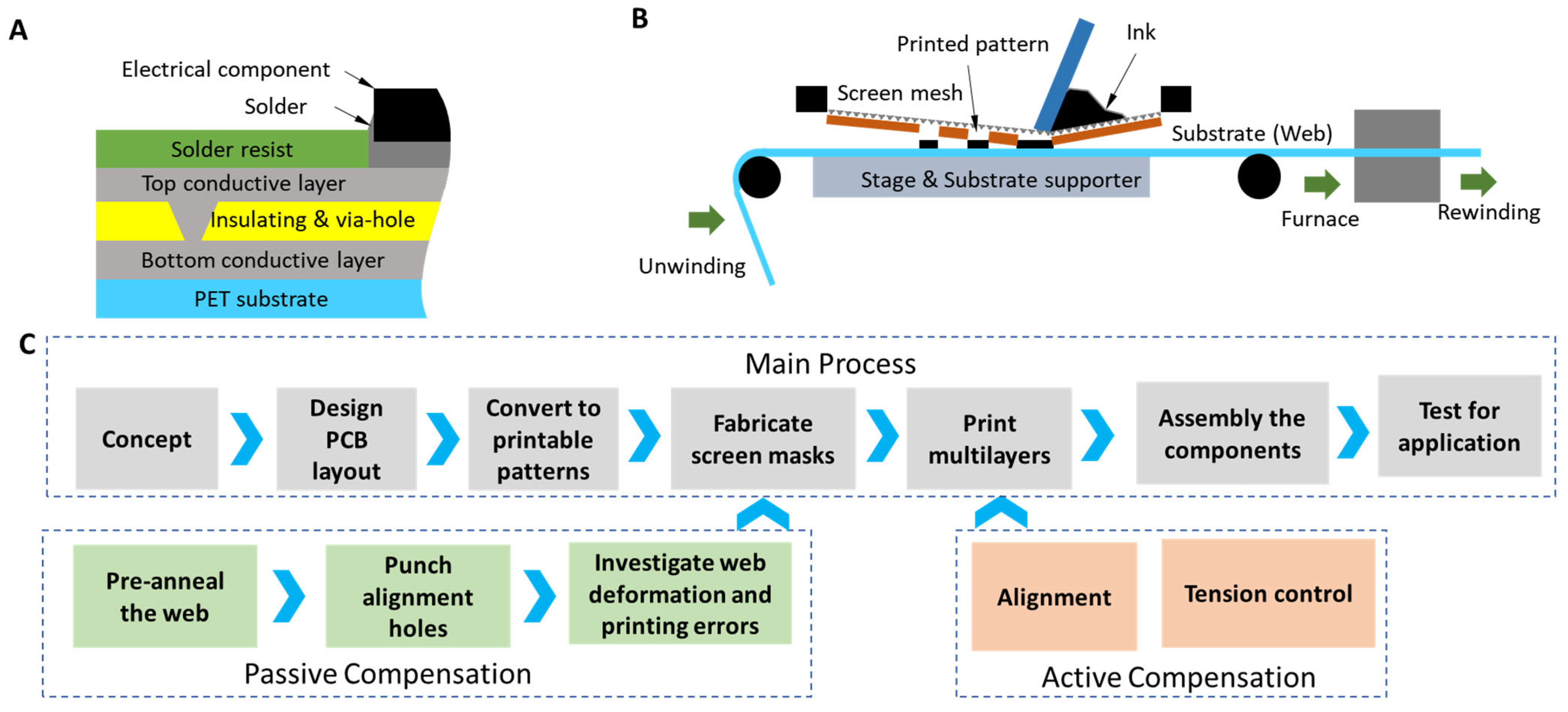
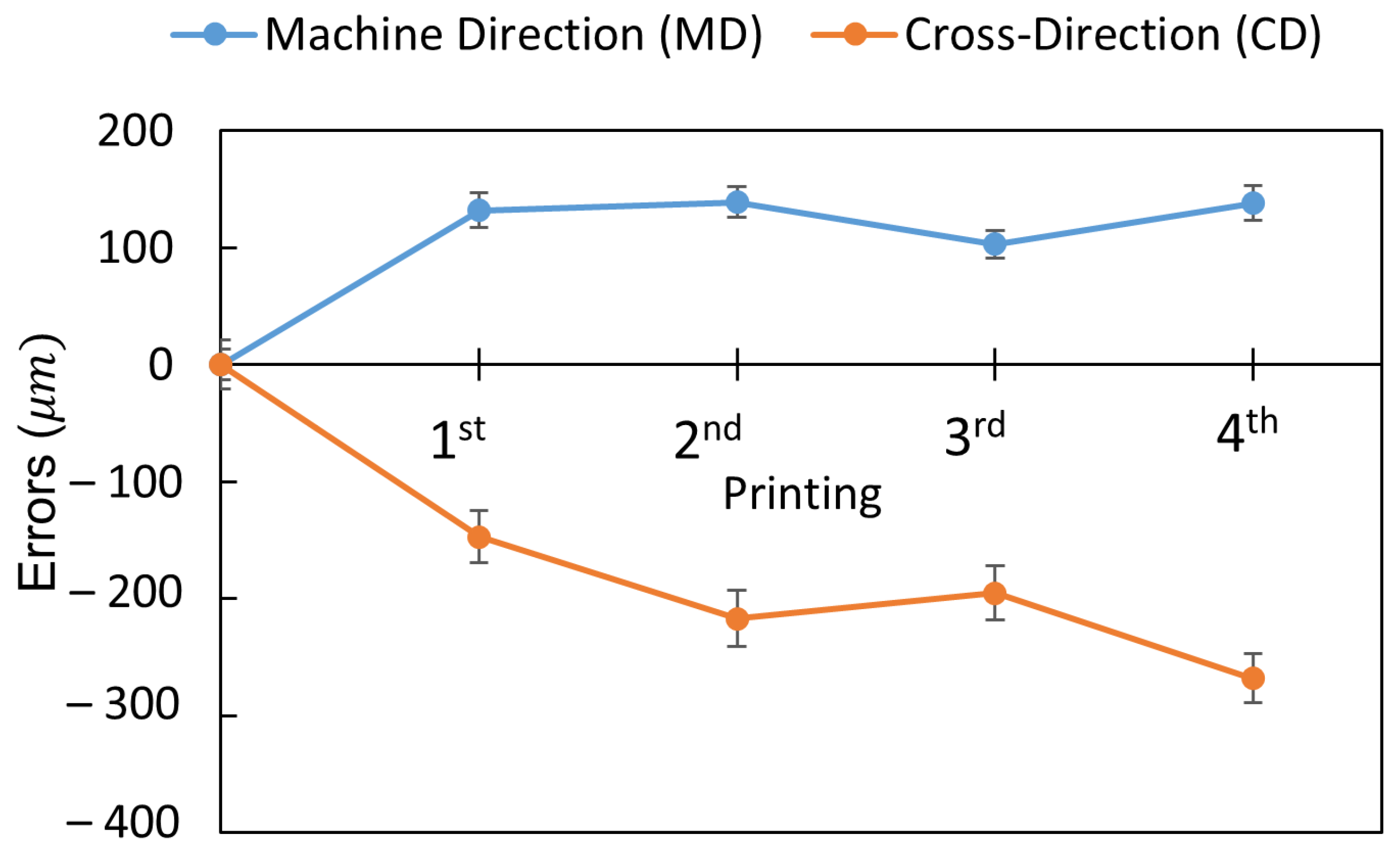





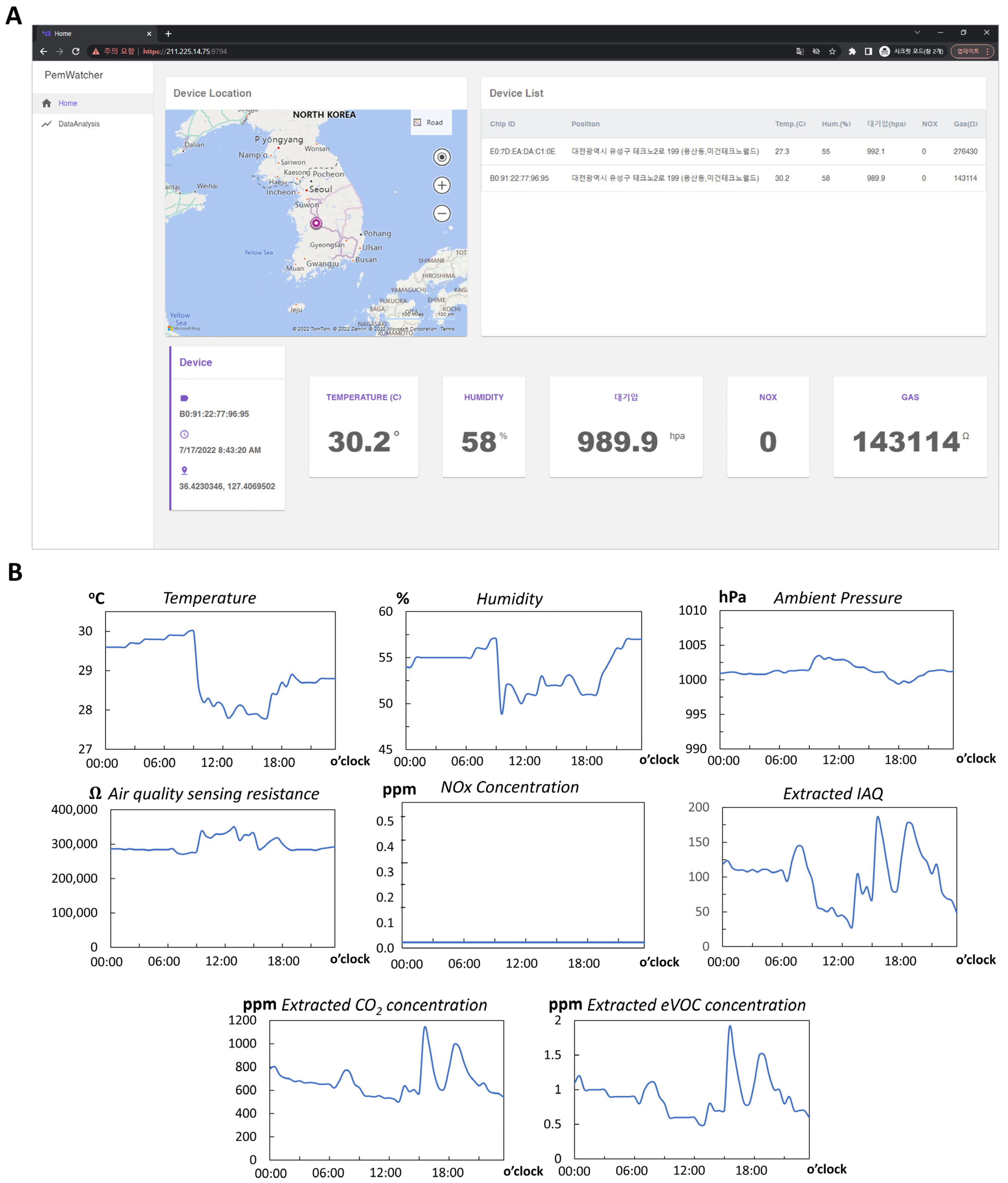
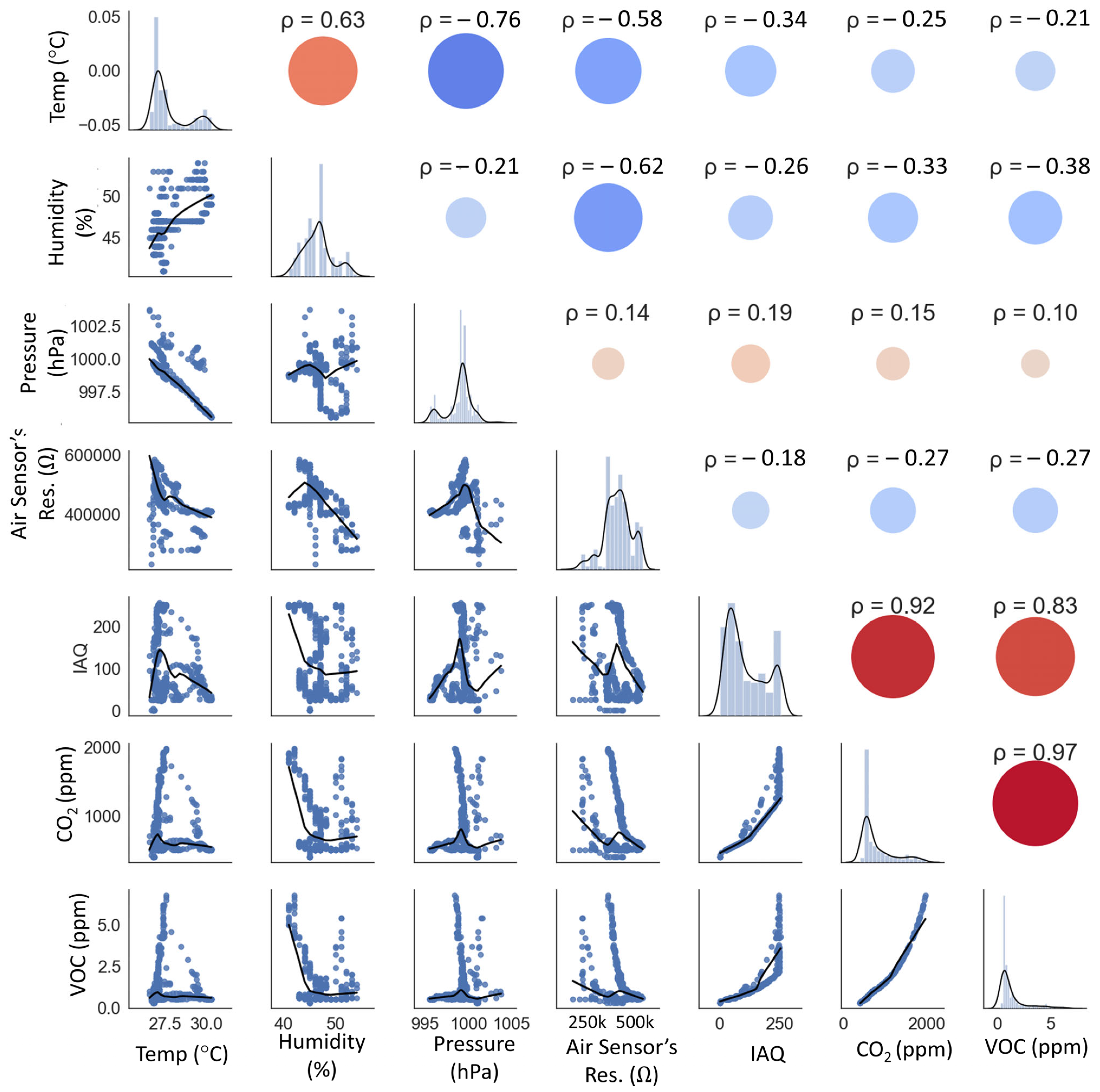
| Parameter | Design Rule | Demonstration |
|---|---|---|
| Conductive trace | Linewidth 200 Power line linewidth 500 Line clearance 500 | 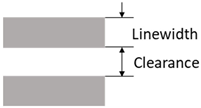 |
| Via holes | Printed insulating hole’s diameter 400 Hole cover diameter 600 In general: |  |
| Passive devices | Device size: 1608 (metric) and above Component clearance: 800 |  |
| Land patterns of active devices | Pad width 300 Pad clearance 200 |  |
| Connectors | Printed FPC connectors at the edges of the circuit (for infrequently used connections) | 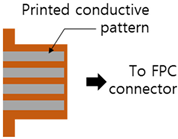 |
| Layer 1 (Bottom Layer) | Layer 2 (Insulating Layer) | Layer 3 (Top Layer) | Layer 4 (Solder Resist) | |
|---|---|---|---|---|
| MD | 1.00004 | 1.00222 | 1.00237 | 1.00202 |
| CD | 0.99476 | 0.99344 | 0.99295 | 0.99213 |
| Layer 1 (Bottom Layer) | Layer 2 (Insulating) | Layer 3 (Top Layer) | Layer 4 (Solder Resist) | |
|---|---|---|---|---|
| Printing material | Silver paste (T40, FP Co., Ltd.) | SFR-300PIY (Seoul Chemical Research Laboratory Co., Ltd.) | Silver paste (T40, FP Co., Ltd.) | SFR-300PIY (Seoul Chemical Research Laboratory Co. Ltd.) |
| Screen mesh-count | 400 | 200 | 325 | 325 |
| Screen mask size: 650 mm × 650 mm | ||||
| Printing condition | Force: 13 kgf | Force: 11 kgf | Force: 13 kgf | Force: 13 kgf |
| The gap between mesh and substrate: 3 mm Squeeze’s speed: 100 mm/s | ||||
| Sintering/annealing | 150 °C–10 min | |||
Disclaimer/Publisher’s Note: The statements, opinions and data contained in all publications are solely those of the individual author(s) and contributor(s) and not of MDPI and/or the editor(s). MDPI and/or the editor(s) disclaim responsibility for any injury to people or property resulting from any ideas, methods, instructions or products referred to in the content. |
© 2023 by the authors. Licensee MDPI, Basel, Switzerland. This article is an open access article distributed under the terms and conditions of the Creative Commons Attribution (CC BY) license (https://creativecommons.org/licenses/by/4.0/).
Share and Cite
Phung, T.H.; Gafurov, A.N.; Kim, I.; Kim, S.Y.; Kim, K.M.; Lee, T.-M. Hybrid Device Fabrication Using Roll-to-Roll Printing for Personal Environmental Monitoring. Polymers 2023, 15, 2687. https://doi.org/10.3390/polym15122687
Phung TH, Gafurov AN, Kim I, Kim SY, Kim KM, Lee T-M. Hybrid Device Fabrication Using Roll-to-Roll Printing for Personal Environmental Monitoring. Polymers. 2023; 15(12):2687. https://doi.org/10.3390/polym15122687
Chicago/Turabian StylePhung, Thanh Huy, Anton Nailevich Gafurov, Inyoung Kim, Sung Yong Kim, Kyoung Min Kim, and Taik-Min Lee. 2023. "Hybrid Device Fabrication Using Roll-to-Roll Printing for Personal Environmental Monitoring" Polymers 15, no. 12: 2687. https://doi.org/10.3390/polym15122687





